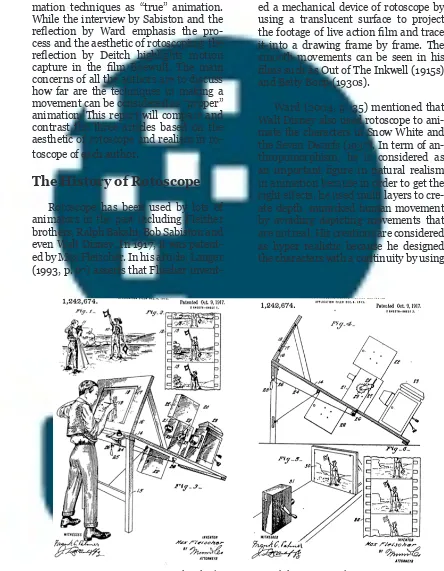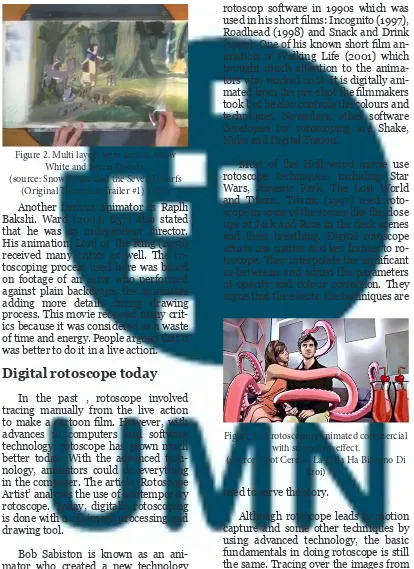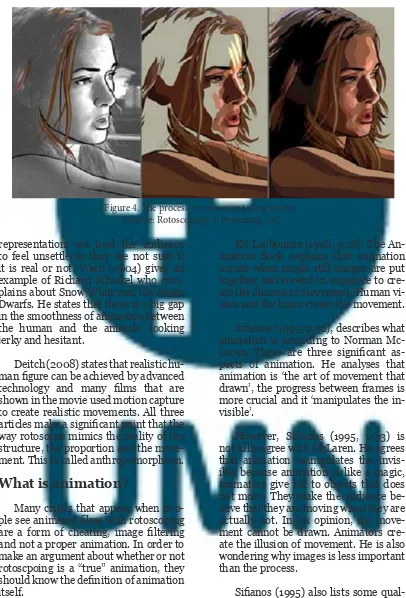Christine Mersiana Lukmanto adalah pengajar tetap
Introduction
The research aims at investigating the use of rotoscoping in animation, to explore a deepe understanding of it.
Throughout this report you will also find
related matters to articles and inter-views that I have researched, I will
iden-tify the techniques used and different definitions of true animation, an real an
-imation, as well as special effects used.
During these articles I will also build upon my ideas of how the concept works from notes throughout class. I will also explain why I have agreed with the au-thors, their ideas and their reasons. I will also look into criticisms of rotoscop-ing and further dialogue surroundrotoscop-ing the issue.Animation has developed over a long period of time. This led to many varied techniques for anim
ators to animate the non-living ob-jects. One such technique is Rotoscope, which is a method which allows
anima-e-mail: [email protected]
tor to trace every single frame from a live action footage to create moving images in the style of cartoon ani-mation (Rotoscope, 2014). In terms of anthropomorphism, rotoscope
creates a realistic effect because it
mimics the reality of the structure, the proportion and the movement. The method has become more ad-vanced with technology by using digital camera to capture live action and computers to trace the
footag-es. However, this realistic effect can
create uncanny feelings because it seems real and unreal at the same time. Moreover, due to an easy pro-cess in animating the characters, there are some critiques and debates about how far rotoscoping can be considered as the “true” animation.
A number of articles (Deitch, 2008; Sabiston, 2011; Ward, 2004) examine the consideration of ani
by tracing every single frame from live action footages and enhancing it with animator’s style.
In terms of anthropomorphism, it creates an uncanny realistic effect because it mimics the
reality of the structure, the proportion and the movement. Due to its easy process in
animat-ing, there are some critiques and debates about how far rotoscoping can be considered as the
“true” animation. This research would cover the identity of rotoscoping, professionals and
animator’s perspective as well as the aesthetic of this technique.
mation techniques as “true” animation. While the interview by Sabiston and the
reflection by Ward emphasis the pro -cess and the aesthetic of rotoscoping; the
reflection by Deitch highlights motion capture in the film Boewulf. The main
concerns of all the authors are to discuss how far are the techniques in making a movement can be considered as “proper” animation. This report will compare and contrast the three articles based on the aesthetic of rotoscope and realism in ro-toscope of each author.
The History of Rotoscope
Rotoscope has been used by lots of animators in the past including Fleisher brothers, Ralph Bakshi, Bob Sabiston and even Walt Disney. In 1917, it was patent-ed by Max Fleischer. In his article, Langer (1993, p. 67) asserts that Fliesher
invent-Figure 1. Max Fleischer’s rotoscope and the way it works. (source: The Fliescher Rotoscope Patent)
ed a mechanical device of rotoscope by using a translucent surface to project
the footage of live action film and trace
it into a drawing frame by frame. The smooth movements can be seen in his
films such as Out of The Inkwell (1915s)
and Betty Boop (1930s).
Ward (2004, p. 35) mentioned that Walt Disney also used rotoscope to ani-mate the characters in Snow White and the Seven Dwarfs (1937). In term of an-thropomorphism, he is considered as
an important figure in natural realism
in animation because in order to get the
Another famous animator is Raplh Bakshi. Ward (2004, p37) also stated that he was an independent director. His animation, Lord of The Ring (1978) received many critics as well. The ro-toscoping process used here was based on footage of an actor who performed against plain backdrops, the animators adding more details during drawing process. This movie received many crit-ics because it was considered as a waste of time and energy. People argued that it was better to do it in a live action.
Digital rotoscope today
In the past , rotoscope involved tracing manually from the live action
to make a cartoon film. However, with
advances in computers and software technology, rotoscope has grown much better today. With the advanced tech-nology, animators could do everything in the computer. The article ‘Rotoscope Artist’ analyses the use of contemporary rotoscope. Today, digitally rotoscoping is done with a 2D image processing and drawing tool.
Bob Sabiston is known as an ani-mator who created a new technology for rotoscoping (2011, p.73). He coop-erated with Flat Black Films to make a
Figure 2. Multi layers were used in Snow White and Seven Dwarfs.
(source: Snow White and the Seven Dwarfs (Original Theatrical Trailer #1) 1937)
rotoscop software in 1990s which was
used in his short films: Incognito (1997),
Roadhead (1998) and Snack and Drink
(1999). One of his known short film an -imation is Walking Life (2001) which brought much attention to the anima-tors who worked on it. It is digitally
ani-mated from the pre-shot the filmmakers
took but he also controls the colours and techniques. Nowadays, other software developed for rotoscoping are Shake, Nuke and Digital Fusion.
Most of the Hollywood movie use rotoscope techniques, including Star Wars, Jurassic Park, The Lost World and Titanic. Titanic (1997) used roto-scope in some of the scenes like the close ups of Jack and Rose in the deck scenes and their breathing. Digital rotoscope artists use mattes and key frames to
ro-toscope. They interpolate the significant
in-betweens and adjust the parameters of opacity and colour correction. They
argue that the effects, the techniques are
Figure 3: A rotoscoping animated commercial with surrealism effect.
(source: Spot Ceres – La Citta Ha Bisogno Di Eroi)
used to serve the story.
Although rotoscope leads to motion capture and some other techniques by using advanced technology, the basic fundamentals in doing rotoscope is still the same. Tracing over the images from
live actions. The differences are they
visual effects and adding some elements
to the drawings. They could make it look more cartoony or realistic. This is known as CG compositing. This is also leads to motion capture. One example of motion capture is “Boewulf” that has been dis-cussed by Deitch.
Therefore, people who are involved in modern rotoscoping in animation studios and productions are often called a “com-positor”. Many animation studios and productions are using rotoscope because of it costs less but still can create good
films. Often it is used for commercials
and products design. One of the commer-cials that used rotoscoping is Spot Ceres – La Citta Ha Bisogno Di Eroi (2012). An Italian drink commercial with less jittery movements. The movements are realistic and the look is cartoon because of the
co-lour. They also added surrealism effects
such as a girl with octopus hands.
The aesthetic of rotoscope
The three authors discuss the aesthetic of rotoscoping and motion capture. There is general agreement among the articles that these methods have great advantages in term of aesthetics in arts.
Both Sabiston (2011) and Ward (2004) claim that rotoscoping has the ability to control the looks and the ani-mation itself. While Sabiston (2011) who is the founder of the Rotoshop software claims that his rotoscoping software is a time and labour saving device, Ward points out that it is seen as a challenge and crucial in animation as in term of its aesthetic and the production. Sabiston’s Rotoshop captures the movement of re-alism and by using interpolation change,
eliminating jittery shimmer. He finds it as
a great skill and artistic ability. Similar-ly, Ward argues that rotoscoping enables animators to produce moving characters with a naturalistic motion. There is an
ex-ample by Ward when he mentions about
the film Walking Life. They used digital
grading, a frame by frame animation so that the movement looks so real and at-tract animators’ attention.
Furthermore, Sabiston (2011)
high-lights rotoscoping is different to motion
capture as it has human element by us-ing hand drawus-ing to express the form of the characters. In addition, the record-ing method is also done by a person not a machine. The aesthetic of rotoscope is so genuine because it is done by hand. However, Deitch (2008) claims that animation should not be categorised by their technical process but rather as
a film as a whole. He also states that it
has no business to imitate live action because the creation can be widely any-thing. The three studies express that ro-toscope creates a great aesthetic that is
different from a hand drawing process.
Realism of rotoscope
The three articles (Sabiston, 2011; Ward, 2004; Deitch, 2008) state that an rotoscoping is anthropomorphism be-cause it mimics the reality so closely.
Sabiston (2011, p.78) describes Ro-toscope as a photorealistic because the movement is so realistic. Even though they trace the actual image, they still draw it by hand and make it look very realistic. It also depends on animators as to how far they mimic reality in their work. In order to accomplish their natu-ral realism image, they could polish the image, with absolute faithfulness to the author and their performance.
According to Ward (2004), due to
the realistic movement effects, audience may find the eerie experience. Because
representation can lead the audience to feel unsettle as they are not sure if it is real or not. Ward (2004) gives an example of Richard Schickel who com-plains about Snow White and the Seven Dwarfs. He states that there is a big gap in the smoothness of animation between the human and the animals, looking jerky and hesitant.
Deitch (2008) states that realistic
hu-man figure can be achieved by advanced technology and many films that are
shown in the movie used motion capture to create realistic movements. All three
articles make a significant point that the
way rotoscope mimics the reality of the structure, the proportion and the move-ment. This is called anthropomorphism.
What is animation?
Many critics that appear when
peo-ple see animated films with rotoscoping are a form of cheating, image filtering
and not a proper animation. In order to make an argument about whether or not rotoscpoing is a “true” animation, they
should know the definition of animation
itself.
Kit Laybourne (1998, p.26), The An-imation Book explains that anAn-imation occurs when single still images are put together and viewed in sequence to cre-ate the illusion of movement. Human vi-sion and the brain create the movement.
Sifianos (1995, p.92), describes what
animation is according to Norman
Mc-Laren. There are three significant as -pects of animation. He analyses that animation is ‘the art of movement that drawn’, the progress between frames is more crucial and it ‘manipulates the in-visible’.
However, Sifianos (1995, p.93) is
not fully agree with McLaren. He agrees that animation manipulates the invis-ible because animation is like a magic, animators give life to objects that does not move. They make the audience be-lieve that they are moving when they are actually not. In his opinion, the move-ment cannot be drawn. Animators cre-ate the illusion of movement. He is also wondering why images is less important than the process.
Sifianos (1995) also lists some qual
ities that animator needs to be a good animator. They should know the timing
between frames. It is a significant deci -sion to time the movement because only their heart can tell, he called it as ‘heart of animation’. Also, animators should study the ‘anatomy of motion’, observe the movement from real life and experience it themselves. For example, when they would like to animate an angry person hitting a table, they should observe when people doing it or even try to hit the table themselves.
Perspectives and reflections
Based on the three articles (Ward, 2004; Deitch, 2008; Sabiston, 2011), I have concluded that Sabiston (2011, p.77) has a fairly balanced view on rotoscoping. Although he agrees that rotoscop is not truly animation considering the value of making from scratch, he points out is not just tracing. He states that even though he works in Rotoshop, the essential is still a form of animation. Sabiston (2011, p.79) says, “It is taking feature from live video and extending them, amplifying, commenting upon, even veering into true animation”. Even though they are tracing from the footages, they still do drawing by hand. Even when they rotoscope in the computer, the artwork is still in the hand of animators. He also against peo-ple who critiques about rotoscope that
say rotoscope is a form of image filtering,
a cheating. He argues that they did not understand how long it takes animator to work up to rotoscoping.
Ward (2004, p.38) agrees that roto-scope is a proper animation. He believes that there is energy in doing rotoscoping and it is crucial because it gives a sense of realism. This is a response to the critique of Lord of The Rings (1978) by Ralph Bakshi. Even though when people argue that ‘it should have done in live-action’, he thinks the aesthetic of the process
in animation is important. In order to
make a better realistic effect, they can
use widescreen or even add colour and synchronise sound.
Although Deitch (2008) talks about motion capture, there is a similar artistic concept and process that happened be-tween rotoscope and motion capture. He thinks that mostly any movie that has been produced today has some
anima-tion if effects animaanima-tion is included and
he mentioned that people should not
categorize films by the techniques. What really matters is the story of the film.
I agree with all of these writers that rotoscope should be considered as true animation because even though basical-ly they trace the footages of live action, they do a lot more in creating the whole
film. They do not trace the whole ani
-mation in the video for the whole film,
the footages are there as the source or reference to animators. They some-times skip over frames. In my opinion,
they also could create a different charac -ter to a human in the video, they could change the shape or add colours and lines. There is a lot of creative freedom possible. Sabiston (2011) states that an-imators tend to think a way to speed up
the process of making a film. In my opin -ion, since the technology is so advanced, the animators have a choice to use the technology. There is nothing wrong to
use what technology has to offer. Just
like farmers who are now using tractor
to plow the field, this does not mean that
they are no longer farmers. I suggest this also applies for animators. In fact, be-ing an animator still requires the skills to be able to give illusion of movements.
Sifianos (1995) highlights that even with
the technologies, they still need to know same basic knowledge, have an under-standing of design and have the patience
and have desire to devote time and effort
Conclusion
All the three types of research make
a significant contribution to an under -standing of how rotoscope works. The articles make useful proposals as to why there are some critiques about rotoscop-ing and what animators say about it. The technology that contributes to animated
films is an interesting filed and is defi -nitely worth closer study as it develops in the future.
This assignment has broadened my understanding on how rotoscoping works, how it was developed and how it has changed during the past few years with computers and software and how it is linked to contemporary animation. Through the articles and interviews,
I find myself agreeing with Sabiston
(2011), Ward (2004) and Deitch (2008).
References:
Brennan, D. (2011). “Arts & Culture: Rotoscoping: A Promising Art”,
Caese-fire Magazine. Retrieved from:http:// ceasefiremagazine.co.uk/rotoscop
-ing-promising-art/
Deitch, G. (2008). “Yes, but is It an-imation?” Animation World Network.
Retrieved from:http://www.awn.com/ articles/production/yes-it-animation
Full Sail University, (2014),
“Roto-scope Artist”. Retrieved from:http:// getinmedia.com/careers/rotoscope-art -ist,
Graphic Design Group A Students. (2012). “PSY Gangnam Style – Roto-scoped”, Fanshawe College. Retrieved
from:https://www.youtube.com/
watch?v=YMnTUcBt0qA,
Laybourne, K. (1998). ‘The Anima-tion Book’, Crown Publishing Group.
Officialceresbeer. (2012, April 16),
Spot Ceres, “Spot Ceres – La Citta Ha
Bisogno Di Eroi” [Video file] Retrieved from : https://www.youtube.com/
watch?v=e9Zm7AqA0G4, viewed on 30 April 2014.
R.K.O. Radio Pictures Inc. (1937). Snow White and the Seven Dwarfs (Original Theatrical Trailer #1) 1937.
Retrieved from:https://www.youtube. com/watch?v=5kWr9e4JN5I,
Rotoscope (2014), In Oxford Dic-tionaries. UK: Oxford University Press.
Retrieved from:http://www.oxforddic
-tionaries.com/definition/english/roto -scope?q=rotoscope,
Rudnyk, M. 1998. “Rotoscoping in the Modern Age”, Animation World
Magazine, Retrieved from : http:// www.awn.com/mag/issue3.2/3.2pag
-es/3.2rudnyk.html.
Sabiston, B. & Ward, P. (2011). ‘Bob Sabiston in Conversation with Paul Ward’, Animation: An Interdisciplinary Journal, pp. 73-82.
Sifianos, G. (1995). ‘The Definition of
Animation: A Letter From Norman Mc-Laren’; Animation Journal, pp. 62-66.


